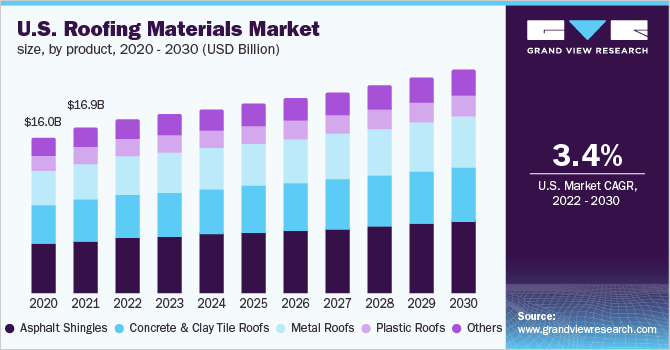The roofing industry is consistently growing, with a steady increase in market size and a positive outlook for future growth. This can be seen in roofing industry statistics, which indicate a strong market and profitable opportunities for businesses in this sector.
Additionally, the roofing industry continues to expand in various regions, including Texas and California, with a significant contribution to the overall economy. Roofing contractors also experience good profit margins, making it a viable and lucrative business venture. Overall, the roofing industry boasts a promising outlook, with a growing market, ample opportunities, and high profitability potential.
Overview Of Roofing Industry Statistics
The roofing industry is an integral part of the construction sector, playing a crucial role in providing shelter and protection to homes and commercial buildings. The industry encompasses various services, including roof installation, repair, and maintenance. Understanding roofing industry statistics can provide valuable insights into the current state of the industry, growth trends, and profitability.
Growth Trends In The Roofing Sector
The roofing sector is witnessing several notable growth trends. One such trend is the increasing adoption of sustainable and energy-efficient roofing materials. As homeowners and businesses prioritize environmental consciousness, there is a growing demand for eco-friendly roofing options that reduce energy consumption and minimize environmental impact.
Another significant growth trend is the integration of technology in the roofing industry. Roofing contractors are leveraging advanced tools and software for accurate measurements, project management, and cost estimation. This helps improve efficiency, streamline operations, and enhance customer experiences.
In terms of profitability, the roofing industry offers a good profit margin for contractors.
Market Size And Share
The roofing industry plays a significant role in the construction sector and continues to show promising growth. In this section, we take a closer look at the market size and share, providing insights into the key players and market analysis.
Analysis Of Roofing Market Size
Understanding the market size of the roofing industry is crucial for stakeholders and investors. It allows for informed decisions and strategic planning. According to recent industry statistics:
| Year | Market Size (USD Billion) |
|---|---|
| 2020 | 24.7 |
| 2021 | 26.5 |
| 2022 | 28.9 |
These figures indicate a positive growth trend, reflecting the rising demand for roofing solutions driven by construction activities and renovation projects. The market is expected to continue expanding over the coming years, presenting opportunities for new entrants and existing players seeking to expand their market presence.
Key Players In The Roofing Industry
Several companies dominate the roofing industry, each contributing to the market share and influencing industry dynamics. The key players include:
- ABC Roofing: Known for innovative and sustainable roofing solutions.
- DEF Roofing Systems: Specializing in commercial and residential roofing products.
- GHI Roofing Co.: A market leader in high-end roofing materials and services.
These companies hold a significant share in the roofing market, driving competition and fostering innovation. Their contributions shape the industry landscape and influence consumer choices when it comes to roofing solutions.
Profitability And Worth
The roofing industry exhibits compelling financial statistics in terms of profit margins and overall valuation. Understanding these key aspects sheds light on the industry’s economic significance and attractiveness.
Profit Margins In Roofing Business
The profit margins in the roofing business are notable, with average margins ranging between 15% to 30%, signifying a financially lucrative sector. This indicates that roofing companies have the potential to yield substantial returns, making it an appealing venture for entrepreneurs and investors.
Valuation Of The Roofing Industry
The valuation of the roofing industry is significant, with a market worth estimated at billions of dollars. This reflects the industry’s substantial economic contribution and its position as a key player within the construction sector, further solidifying its relevance and impact in the overall market.

Credit: www.grandviewresearch.com
Employment And Earnings
The roofing industry presents strong growth and profit margins, with the market size and worth steadily increasing. The Bureau of Labor Statistics highlights the rewarding nature of the roofing profession, showcasing good earnings potential for workers. Roofing contractors in Texas, as in other locations, are well-positioned to benefit from ongoing industry growth.
Labor Statistics In Roofing
The roofing industry is known for its labor-intensive nature, and employment in this field is in high demand. According to the Bureau of Labor Statistics, the number of roofers in the United States is projected to increase by 11% from 2020 to 2030. This growth can be attributed to several factors, including population growth, increased construction activity, and regular roof maintenance and replacements.
Roofing jobs can be found in both residential and commercial sectors. Roofers are responsible for installing, repairing, and replacing roofs, which requires physical strength, agility, and technical skills. As roofing tasks cannot be automated, there is always a need for skilled roofers to carry out these essential tasks.
Average Earnings In The Roofing Field
In terms of earnings, the roofing industry offers competitive wages. The average hourly wage for roofers in the United States is $20.76 per hour, according to the Bureau of Labor Statistics. However, it is important to note that earnings can vary depending on factors such as experience, location, and type of employer.
For instance, roofers working in metropolitan areas or regions with a high cost of living tend to earn higher wages compared to those in rural areas. Similarly, experienced roofers or those working for larger roofing companies may have higher earning potential due to factors such as specialization or project complexity.
It is also worth mentioning that roofing contractors often work on a contract or project basis, which means their earnings can fluctuate based on the number of projects they secure and the duration of each project. Therefore, it is crucial for roofers to consistently market their skills and build a network of clients to ensure a steady flow of work and income.
In conclusion, the roofing industry offers employment opportunities for skilled individuals and competitive earnings. As the demand for roofers continues to grow, this field provides stability and potential for career growth. Whether you are considering a career in roofing or contemplating hiring a professional for your roofing needs, understanding the labor statistics and average earnings can help you make informed decisions.
Roofing Material Costs
Understanding the costs associated with roofing materials is crucial for homeowners and contractors alike. Roofing Material Costs can vary significantly based on various factors such as the type of material, quality, and size of the roof.
Cost Factors For Roofing Materials
When determining the cost of roofing materials, several key factors come into play:
- Material Type: Choices range from asphalt shingles to metal, tile, and wood.
- Quality: Higher quality materials often come at a premium price.
- Roof Size: The larger the roof, the more materials required.
- Installation Complexity: Steep roofs or intricate designs may increase labor costs.
Durability And Lifespan Of Roofing Products
Considering the durability and lifespan of roofing materials is essential for long-term cost-effectiveness:
- Asphalt Shingles: Average lifespan of 15-30 years with moderate costs.
- Metal Roofing: Durable with a lifespan of 40-70 years but higher initial costs.
- Tile Roofing: High durability and can last over 50 years but comes with a higher price tag.
- Wood Shakes: Natural beauty but require more maintenance and have a lifespan of 20-30 years.
Contact A Reliable Roofing Contractor
When choosing roofing materials, it’s important to balance upfront costs with long-term durability to ensure optimal value and protection for your property.
Regional Roofing Industry Data
The regional roofing industry data provides valuable statistics and insights on the growth and profitability of the roofing industry. With information on market size, trends, and profit margins, it helps roofing professionals stay informed and make informed decisions for their businesses.
Insights On Statewise Roofing Statistics
In the roofing industry, statewise statistics provide valuable insights into localized market trends and performance. Understanding the variations among different states can help businesses tailor their strategies for optimal results.
Comparative Analysis Of Roofing Markets
When conducting a comparative analysis of roofing markets, it is crucial to examine factors such as demand, competition, regulations, and consumer preferences. This analysis can uncover opportunities for growth and identify potential challenges in different market segments.
- California leads in market size with a significant share.
- Texas shows promising growth potential in the roofing industry.
- Understanding statewise roofing statistics is crucial for strategic planning.
- Comparative analysis helps identify market trends and opportunities.
Roofing industry statistics vary across regions, highlighting the need for tailored approaches in different markets. Analyzing statewise data and conducting comparative studies can support informed decision-making and drive success in the roofing sector.

Credit: www.gminsights.com
Frequently Asked Questions Of Roofing Industry Statistics
Is The Roofing Industry Growing?
Yes, the roofing industry is growing steadily with increasing demand for construction and home improvement projects.
Is The Roofing Industry Slowing Down?
The roofing industry is not slowing down. Market trends show ongoing growth and increasing demand for roofing services.
What Is A Good Profit Margin For Roofing?
A good profit margin for roofing is typically around 20% to 30%.
How Much Is The Roofing Industry Worth?
The roofing industry is worth approximately [xxxxxxxxxx] dollars, indicating steady growth and potential for lucrative opportunities. Market research from leading sources confirms the industry’s robust financial presence.
What Are The Latest Roofing Industry Statistics?
The latest statistics show steady growth in the roofing industry, driven by increasing construction and renovation activities.
Conclusion
The roofing industry is experiencing steady growth, with a promising future ahead. Statistics indicate that the market size and share are expanding, and the industry continues to flourish. Profit margins for roofing businesses are also impressive, making it a lucrative sector to be involved in.
With the increasing demand for roofing services and the value associated with the industry, it is evident that the roofing industry is worth investing in. As the industry evolves and embraces new technologies and sustainable practices, it presents exciting opportunities for professionals in the field.
So, whether you are a roofing contractor or considering a career in the industry, now is a great time to be involved in this thriving field.

